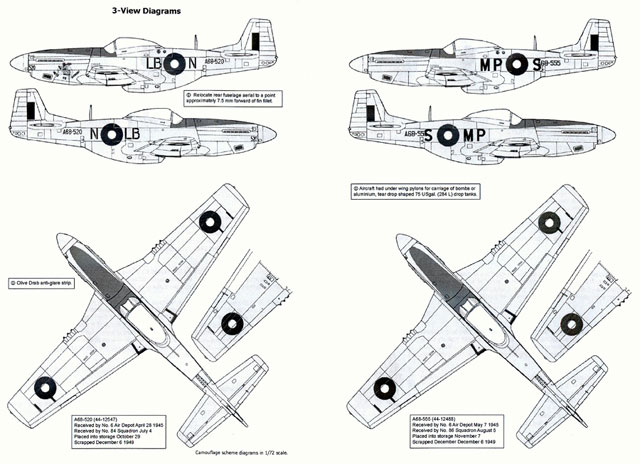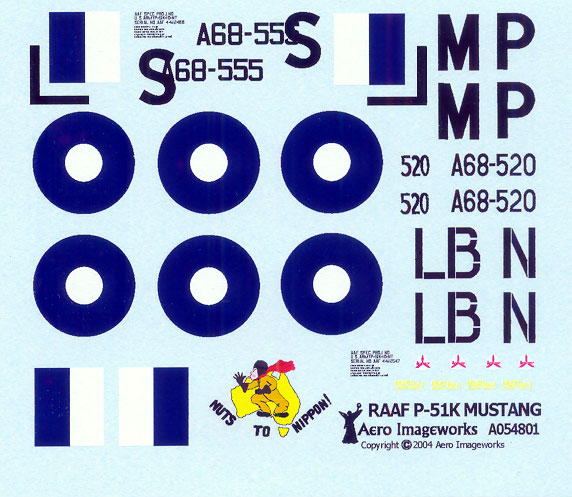S u m m a r y
|
| Catalogue
Number and Description: |
A0154801 RAAF P-51K
Mustang |
| Scale: |
1/48 |
| Contents and Media: |
One decal sheet;black & white printed, reference booklet with three view paint
guides, painting, weathering and detailing instructions, history and
diagrams. |
| Price: |
AUD$19.95
(USD$14.50) - available online from Aero Imageworks |
| Review Type: |
FirstLook |
| Advantages: |
Interesting markings;
comprehensive reference and documentation; online access to
additional material; accurate depiction of subjects |
| Disadvantages: |
Decal film covers entire
sheet (markings must be carefully cut out) |
| Recommendation: |
Highly Recommended |
Reviewed by Rodger Kelly

HyperScale is proudly sponsored by
Squadron
New from Aero Imageworks,
the Victor Harbour, South Australia based company, is sheet number
A0154801. The sheet provides markings for two late-war Royal
Australian Air Force (RAAF) P-51K Mustangs.
The RAAF operated Mustangs
in the Pacific theatre towards the end of WW2 and received 90 U.S.
P-51K and P51D Mustangs between April and September of 1945. The
markings on this sheet are for two of these aircraft.

Both are finished in the
delivery scheme of natural metal fuselage with an olive drab
anti-glare panel. The wings were painted with aluminium lacquer
(less the flaps, ailerons, tank bay access doors, and undercarriage
doors) as was the rudder. Careful study of photographs also reveals
that aluminium paint was also used around various panels on the
fuselage.
The individual aircraft and
their markings are:
A68-520 "Nuts to Nippon" of
84 Squadron as it appeared at the Ross River Strip, Townsville,
Queensland in July-August of 1945. The supplied markings are:
-
LB squadron
codes (84 Squadron) and individual aircraft letter N in black.
The letters are in the stencil style used by 84 Squadron.
-
Nose art,
comprising the slogan "Nuts to Nippon" with a cartoon pilot
thumbing his nose, superimposed over a map of Australia.
-
Serial number
A68-520 in black for the rear fuselage.
-
"Last three"
of the serial in black for the nose.
-
Serial data
block.
A68-555 of 86 Squadron, as
it appeared at Bohle River Airstrip, Townsville, Queensland in
August 1945. The supplied markings comprise:
-
MP squadron
codes and individual aircraft letter S in black. Again, these
letters are in the unique broad stroke font used exclusively by
86 Squadron.
-
Serial number
A68-555 in black for the rear fuselage.
-
Serial data
block.

The data blocks for each of
the aircraft are legible and can be read under magnification. They
bear the correct USAAF serial numbers (44-12547 for A68-520 and
44-12488 for A68-555). Unfortunately, they lack the words
"Australian Government" that was stencilled above the first line of
the block. I understand though that this has been addressed and
will be corrected before the sheet is released.
A single set of national
insignia (six roundels and a pair of fin flashes) is supplied as are
a set of yellow data blocks and aeroproducts logos for the
propeller. A pair of black "No Step" outlines for the inner upper
surfaces of the flaps is also supplied. These should be in red and
again, will be corrected before the sheet is released.
The decals themselves look
to be printed using the thermal process (Alps Printer type decals).
They are beautifully thin and in perfect register bar the two 520s
for the nose of the first option. These two decals appear to be a
little smudged but as my sample was one of the first printed I
suspect that this will not be the case with the ones released for
sale. Be aware that decals produced by this process are as equally
as good as ones you are used to (silk screen) but they do require
each subject to be cut close to the design as the whole sheet is one
big carrier film. They are thin, so use plenty of water to float
them to where they should be and you won't have a problem.
The placement guide is in
the Aero Imageworks excellent booklet style. It contains:
-
Concise, clear
instructions on how to apply the decals.
-
A short
history of the use of the Mustang by the RAAF (both those
received from the U.S. and those produced in Australia by the
Commonwealth Aircraft Corporation – CA-17s, 18s and 22s)
-
Comprehensive
information on the assignments of each of the machines from
their receipt by the RAAF in 1945 to their scrapping in 1949.
-
1/72 scale
three-view drawings of each aircraft.
-
Camouflage and
markings.
-
A short
discourse on the Aeroproducts propeller.
-
A lengthy
explanation of the "Nuts to Nippon" nose art, how it came about
and what it means.
-
The flying
clothing and equipment worn by RAAF pilots in the Pacific
theatre.
The placement guide also
advises on the canvas cover worn over the radio rack. U.S. built
RAAF Mustangs had different radio gear from their USAAF cousins and
it was arranged differently. Fortunately, you can get away without
modifying your kit as RAAF machines wore a canvas cover over the
area to protect the radio gear from the sun. To get an idea of what
this cover looked like, visit the Monash University website
http://www.ctie.monash.edu.au/hargrave/images/an005425_500.jpg
There are also some
excellent photographs of 84 Squadron aircraft available from the
Australian War Memorial Photographic Collection that were taken at
the Ross River Strip. If you visit their site at
http://www.awm.gov.au/database/collection.asp and type Mustang
+84 Squadron into their search engine you will be rewarded with 13
excellent photographs to help you with your build.
The guide book and
the decal sheet come packed in a clear plastic zip-loc bag.
All up, an excellent
sheet from Aero Imageworks. It supplies markings for two unique
RAAF P-51Ks that have never been produced before as well as
comprehensive information via the Guidebook..
Highly
Recommended.
Postscript
If you have the old Peter N. Anderson Book Mustangs of the RAAF and
RNZAF, there are photographs of both these machines on pages 22 and
23, the only photographs I have ever seen of them.
If you are contemplating building a model any of the Mustangs
operated by the RAAF you can not find a better reference than The
Red Roo Models Publication "The Modeller's Guide to the RAAF
Mustang" by Gary Byk. The book is available direct from their
website
http://www.redroomodels.com/
Don't build one without it!
Review Copyright © 2004 by
Rodger Kelly
This Page Created on 18 August, 2004
Last updated
17 August, 2004
Back to
HyperScale Main Page Back to Reviews Page |
Home | What's
New | Features
| Gallery |
Reviews | Reference
| Forum
| Search